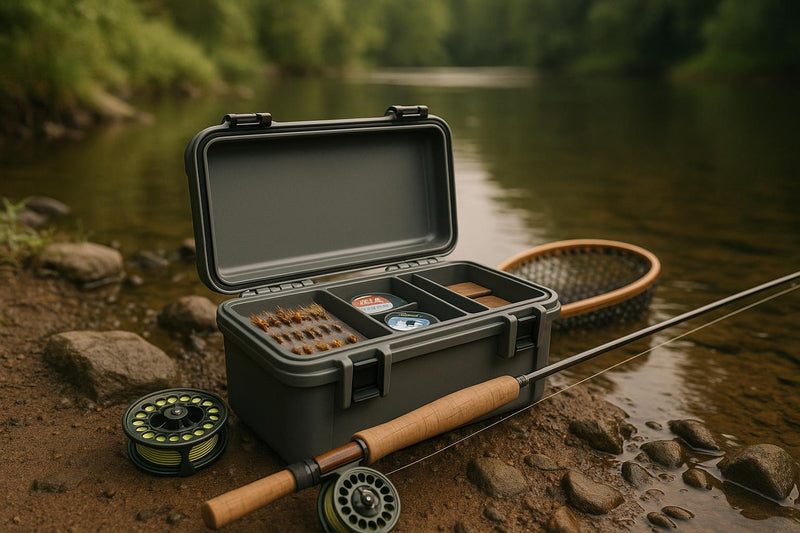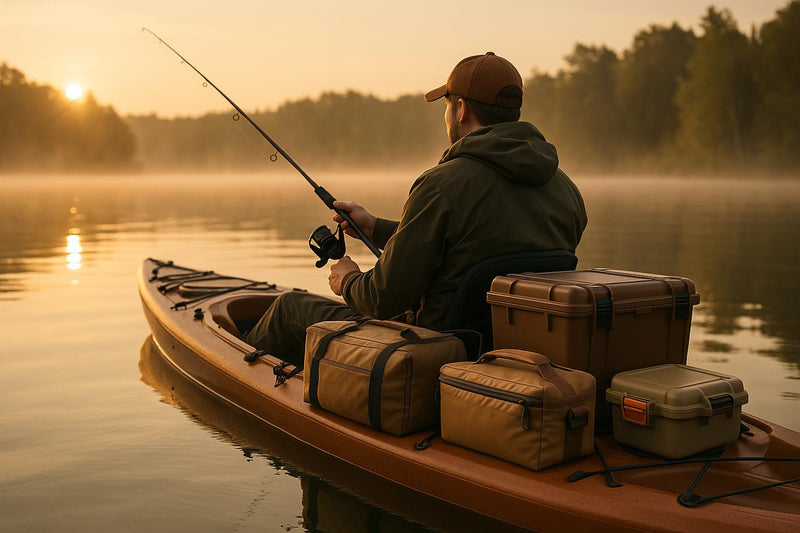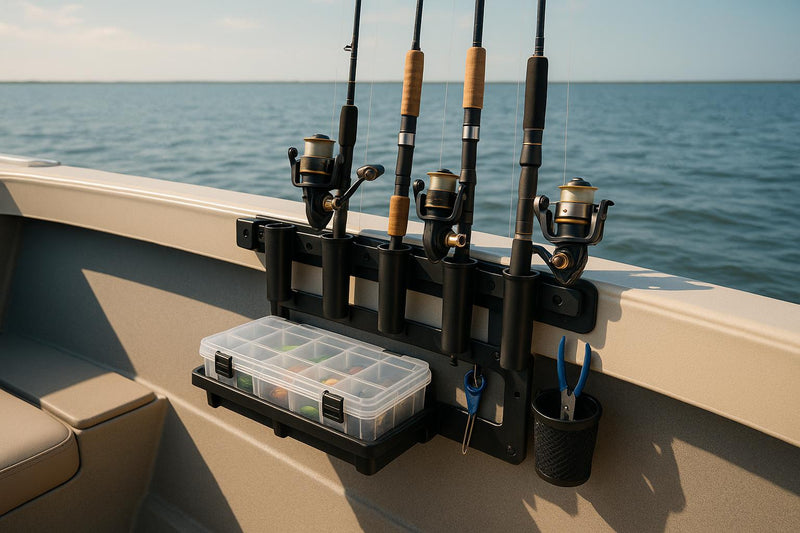Fishing shorts need to handle tough conditions like water, UV rays, and abrasions while keeping you comfortable. The best materials for padded fishing shorts are:
- Nylon: Durable, water-resistant, and easy to care for, but less breathable.
- Polyester: Tear-resistant, lightweight, and quick-drying with UV protection.
- Neoprene: Flexible and insulating, ideal for cooler conditions but not breathable.
- Technical Blends: Combine fibers like cotton, polyester, or spandex for durability, stretch, and moisture-wicking.
Quick Comparison
| Material | Durability | Comfort | Water Resistance | Breathability |
|---|---|---|---|---|
| Nylon | High | Moderate | High | Moderate |
| Polyester | High | High | High | Moderate |
| Neoprene | Moderate | Moderate | High | Low |
| Technical Blends | Varies | High | Varies | High |
Each material offers unique strengths. Nylon and polyester are excellent for durability and water resistance. Neoprene is best for cold or wet conditions, while technical blends provide balanced performance for all-day use.
Top 5 Best Fishing Shorts Review in 2023 | Will Surprise You!
1. Nylon
Nylon has earned its place as a go-to material for padded fishing shorts, thanks to its long-standing reputation in outdoor gear and its ability to handle tough conditions.
Durability
When it comes to durability, nylon is a standout. It holds up well under the wear and tear of fishing and other outdoor activities, resisting abrasions even with frequent use. High-quality padded fishing shorts often use 100% Nylon Taslon, a fabric known for its toughness and abrasion resistance. Plus, nylon shorts are easy to care for - they're machine washable and hold up well over time, making them a solid choice for outdoor adventures and travel.
Water Resistance
Nylon offers decent water resistance, though it’s not fully waterproof. Its structure includes hydrophobic "islands" that repel light splashes. However, nylon can absorb about 1.5–3.5% of its weight in moisture, depending on the specific type. For fishing, this means it handles occasional splashes well but may let water through during heavy rain or prolonged exposure. To address this, many manufacturers add Durable Water Repellent (DWR) coatings, which cause water to bead and roll off the fabric's surface.
Breathability
Breathability isn't nylon's strong suit. Tightly woven nylon can trap heat and moisture, which may lead to discomfort during long fishing trips. Basic nylon fabrics can even cause excessive sweating by holding onto heat and slowing down moisture evaporation. But modern advancements have made a big difference. Many padded fishing shorts now incorporate moisture-wicking features and lightweight designs to help you stay cooler and drier, even in warm, humid conditions. Quick-dry treatments are another common improvement, speeding up moisture evaporation for added comfort. While nylon can sometimes retain odors, its quick-drying ability makes it a practical choice for shifting between different fishing environments.
Next, we'll take a closer look at polyester, which offers its own unique set of benefits.
2. Polyester
Polyester has earned its place as a go-to material for fishing gear, especially in padded fishing shorts. Its mix of performance features makes it a reliable choice for anglers who spend long hours on the water.
Durability
Polyester stands out for its toughness. While nylon is known for its abrasion resistance, polyester takes it a step further with better tear resistance and the ability to hold its shape. It resists stretching, shrinking, wrinkling, creasing, and tearing, making it ideal for rugged fishing conditions. This durability ensures that your padded fishing shorts keep their fit and look, even after countless hours of use. Plus, polyester is designed to handle rough surfaces and sharp fishing gear without losing its structural integrity.
Comfort
Comfort is one of polyester's strongest suits, especially for anglers. Its lightweight feel makes it suitable for long fishing trips. Add to that its moisture-wicking properties, which pull sweat away from your body, and you’ve got a fabric that keeps you dry and comfortable all day. Many polyester fishing shorts also offer UPF30 to UPF50 protection, helping shield you from harmful UV rays during those sun-drenched fishing sessions.
Water Resistance
Polyester performs exceptionally well in wet conditions. Water beads up on its surface instead of soaking in, and its quick-drying nature means your gear is ready to go again in no time. Some manufacturers enhance this water resistance further by applying coatings like polyurethane, creating an even stronger shield against moisture. On top of that, polyester retains its vibrant colors and resists fading, so your shorts continue to look sharp season after season.
Breathability
Breathability can be a bit of a trade-off with polyester. Unlike natural fabrics like cotton, it isn’t naturally breathable. However, advancements in fabric technology have improved this aspect. Modern polyester blends used in padded fishing shorts are designed with moisture-wicking properties that move sweat away quickly. High-quality fishing shorts often include fabric constructions that enhance airflow while still maintaining the durability and water resistance anglers need. When comparing padded fishing shorts vs. regular shorts, these specialized polyester blends often come out on top for moisture management.
Next, let’s dive into neoprene, a material that takes water resistance to another level.
3. Neoprene
Neoprene, a synthetic rubber, stands out in tough water environments thanks to its flexibility and durability. It's a go-to material for anglers and outdoor enthusiasts who need reliable performance in challenging conditions.
Durability
Neoprene is known for its combination of strength and flexibility, which ensures both durability and freedom of movement. To make it even tougher, manufacturers often reinforce key areas. For example, neoprene-reinforced knees with Kevlar® protection and extra padding in seat areas help extend the life of garments. Thickness also plays a role in durability - Sea-Doo’s women’s neoprene shorts use 2 mm neoprene for solid protection, while lighter options, like Courier’s 1 mm neoprene short liners, are better suited for less demanding conditions. Beyond its physical strength, neoprene also offers dependable water resistance, making it a versatile choice.
Water Resistance
Neoprene is water-resistant, though not entirely waterproof. Its closed-cell structure, filled with tiny gas bubbles, limits water absorption to less than 5% in closed-cell neoprene. While materials like PVC and rubber provide full waterproofing, they lack the flexibility and insulation that neoprene offers. For anglers looking for gear that keeps them dry without restricting movement, neoprene strikes a practical balance. This quality is especially valued in discussions about water-resistant gear that protects anglers. Its water resistance, combined with its durability, makes neoprene a reliable choice for wet and demanding conditions.
Comfort
One of neoprene’s standout features is its ability to protect the skin and retain warmth, making it perfect for early mornings or cooler water temperatures. Features like reinforced knees and adjustable elements enhance comfort even further, giving neoprene shorts an advantage over standard options in wet environments. When comparing padded fishing shorts with regular shorts, neoprene often wins out for its warmth and insulation, even when wet.
Breathability
While neoprene excels at insulation, it sacrifices breathability, making it more suitable for cooler conditions. Its hydrophobic nature allows it to dry quickly, but it doesn’t transfer moisture as effectively as high-performance breathable fabrics. For a deeper dive into the science of moisture-wicking materials, check out our guide on quick-dry fabric technology. This trade-off makes neoprene a better choice when warmth and water resistance are priorities over ventilation.
sbb-itb-cb0a783
4. Technical and Blended Fabrics
Technical and blended fabrics are crafted by combining fibers to deliver unmatched durability, comfort, and protection for anglers. Unlike traditional single-fiber materials, these advanced fabrics are specifically designed to enhance performance, offering a balance that single-fiber materials can't achieve. By merging the strengths of different fibers, these blends elevate padded fishing shorts to a whole new level of functionality.
"Technical fabrics are engineered first for function, not merely aesthetics." – Angie, Co-founder and Fashion Stylist, YouLookFab.com
These fabrics blend natural and synthetic fibers to create advantages that standalone materials can't replicate. Popular combinations include cotton-polyester blends, which combine the softness and breathability of cotton with the durability and moisture-wicking properties of polyester. Cotton-spandex blends add stretch for active wear, while polyester-wool mixes enhance insulation, making them ideal for cooler fishing conditions.
Durability
Designed to handle the demands of fishing, technical blends like nylon and polyester are built for strength. By combining the best traits of different fibers, these fabrics achieve exceptional durability. For example, cotton-polyester blends pair cotton's natural comfort with polyester's wrinkle resistance and longevity. Manufacturers also apply finishing treatments to improve resilience, ensuring these fabrics stand the test of time.
Reinforcement fibers are often added to technical fabrics, significantly extending their lifespan. These materials are lightweight, fast-drying, stretchable, and resistant to creases, making them perfect for the challenging environments anglers encounter. Synthetic fibers used in these blends are specifically engineered to endure repeated stress and exposure to the elements while maintaining their shape and performance. Additionally, this durability improves resistance to water penetration, a key feature for fishing apparel.
Water Resistance
Technical fabrics are often designed with weatherproof and waterproof properties. Many use layered constructions that block water while allowing heat and sweat to escape, ensuring breathability. According to a study by Radostina A. Angelova from the Technical University of Sofia, published on July 30, 2025, features like moisture-wicking, thermoregulation, UV protection, antimicrobial treatments, and DWR (durable water repellent) coatings are essential for high-performance outdoor textiles.
Comfort
Comfort is a top priority in technical and blended fabrics. Advanced moisture-wicking properties and temperature regulation help keep anglers dry and comfortable during long hours on the water. Blends that include spandex or elastane provide added stretch and flexibility, making movement easier whether you're casting or maneuvering around a boat. Some blends with spandex can stretch up to 100 times their original length, while moisture management ensures you stay dry. This combination of stretch, moisture control, and temperature regulation makes these fabrics ideal for all-day fishing trips.
Breathability
Breathability is another standout feature of technical fabrics. These materials are designed to allow sweat to escape and reduce heat buildup, keeping the skin dry and preventing irritation or overheating. Unlike cotton, which retains moisture, technical fabrics wick it away and dry quickly. This rapid moisture transfer helps regulate body temperature, providing ongoing comfort. For anglers who value quick-dry fabric technology, these fabrics are a game-changer.
Additionally, many technical fabrics offer UV protection, with clothing often featuring a UPF rating of 50+ to block at least 98% of harmful UV rays. This makes them an excellent choice for Mens Fishing Shorts designed for long days spent under the sun. Whether you're battling the elements or relaxing on the water, these fabrics deliver performance and protection.
Material Comparison: Strengths and Weaknesses
Picking the right material for your fishing shorts is all about understanding how different fabrics perform in the areas that matter most to anglers. Each option has its own set of pros and cons that can directly impact your comfort and performance while out on the water.
| Material | Durability | Comfort | Water Resistance | Breathability |
|---|---|---|---|---|
| Nylon | High | Moderate | High | Moderate |
| Polyester | High | Moderate | High | Moderate |
| Neoprene | Moderate | Moderate | High | Low |
| Technical Fabrics | Varies | Varies | Varies | Varies |
This table highlights how each material performs in key areas, helping you make an informed decision for your fishing needs.
Nylon is a standout for its durability, making it a great choice for withstanding the wear and tear of fishing environments. It holds up well against abrasions from waves, reefs, and other rough conditions, ensuring your gear lasts longer. Polyester, on the other hand, shares nylon’s durability but adds excellent moisture control and shape retention. It resists stretching, shrinking, and tearing, making it a reliable option for shorts that see heavy use.
If you’re fishing in cooler conditions, neoprene shines with its insulating properties. However, it’s not the best choice for warmer weather due to its lack of breathability . For those looking for a balance of features, technical and blended fabrics combine natural comfort with synthetic durability and moisture-wicking abilities. These materials vary widely in performance depending on their specific blend and construction.
For anglers facing rugged environments, nylon and polyester are top choices for their toughness. In colder settings, neoprene offers the warmth you need. Meanwhile, technical fabrics provide multi-functional solutions, adapting to a variety of conditions.
Understanding these material differences also sheds light on why modern fishing shorts and casual cargo shorts perform so differently in aquatic settings. By comparing these options, you’ll be better equipped to choose padded fishing shorts that meet your specific fishing demands.
Conclusion
Selecting the best material for your fishing shorts comes down to aligning the fabric's properties with the challenges of your fishing environment. Nylon is a go-to for its toughness and resistance to abrasions, making it ideal for rough conditions. Polyester, on the other hand, balances comfort and durability, offering UV protection and long-lasting color retention.
If you're fishing in colder waters, neoprene provides insulation, though it might feel stifling on hotter days. For those seeking all-around performance, technical and blended fabrics combine moisture-wicking, stretch, and weather resistance to handle a variety of conditions with ease.
When choosing fishing shorts, also consider additional features that enhance performance. UPF protection shields you from harmful UV rays, while moisture-wicking fabrics and stretch materials ensure comfort and freedom of movement. Quick-drying properties are a must if you're likely to get wet, keeping you dry and comfortable throughout your trip.
Practical design elements, such as adjustable waistbands and water-resistant finishes, can make a big difference during long hours on the water.
Reel Comfort’s padded fishing shorts, priced at $59.99, embody these qualities. They feature strategic padding, quick-dry fabric, and a water-resistant build, designed to withstand saltwater, sun, and multiple wash cycles. As the company highlights:
"Designed for serious anglers, our shorts offer strategic padding and quick-dry fabric, helping you stay cool, supported, and focused on the catch."
For a deeper dive into fishing gear, you can explore topics like how water-resistant gear protects anglers and the science behind quick-dry fabric technology. Choosing the right materials ensures your men’s fishing shorts deliver when it counts - keeping you comfortable and ready to reel in that dream catch.
FAQs
Why are technical and blended fabrics better for padded fishing shorts than traditional materials?
Technical fabrics, such as moisture-wicking and quick-drying materials, are crafted to offer water resistance, breathability, and odor control - a perfect combination for extended fishing trips. These fabrics help you stay dry and comfortable, even when the conditions get tough.
Blended fabrics take things a step further by combining the best qualities of different fibers. For instance, they mix the softness of cotton with the durability and quick-drying abilities of polyester. The result? Fishing shorts that are not only comfortable but also long-lasting and low-maintenance. These modern materials outperform traditional choices like plain cotton or nylon, delivering better performance, comfort, and durability.
What makes neoprene shorts a good choice for fishing in cold weather?
Neoprene shorts are a go-to option for fishing in cold weather, thanks to their ability to trap body heat and keep you warm even when temperatures drop. Plus, their waterproof design ensures you stay dry, which is a game-changer in wet and chilly conditions.
When it comes to warmth and water resistance, neoprene stands out from other materials. For anglers braving icy waters, these shorts offer both comfort and protection, letting you focus on reeling in your catch instead of battling the cold.
Are nylon and polyester fishing shorts comfortable and breathable enough for long trips in warm weather?
Yes, fishing shorts made from nylon or polyester are perfect for long days on the water in warm weather. These materials are lightweight, quick-drying, and moisture-wicking, helping you stay cool and comfortable even when temperatures rise. Plus, their breathable and water-resistant properties make them a practical choice for spending hours near or on the water.
For added comfort, consider shorts with thoughtful features like stretch fabric or adjustable waistbands. These details improve mobility and ensure a better fit, so you can fully enjoy your fishing trip without worrying about discomfort or overheating.




